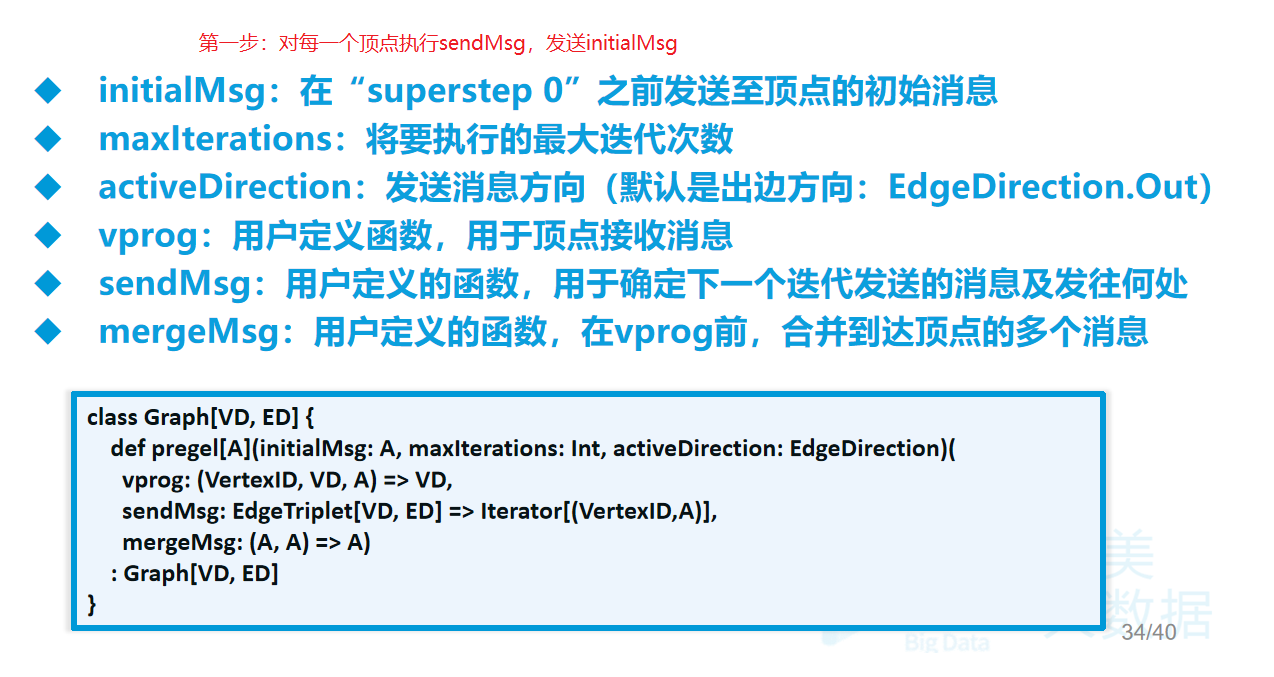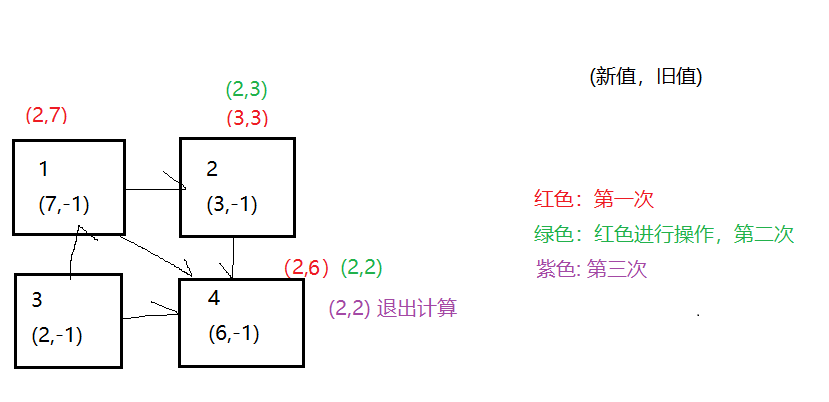Pregel是Google提出的用于大规模分布式图计算框架
- 图遍历(BFS)
- 单源最短路径(SSSP)
- PageRank计算
Pregel的计算由一系列迭代组成,称为supersteps
Pregel迭代过程
- 每个顶点从上一个superstep接收入站消息
- 计算顶点新的属性值
- 在下一个superstep中向相邻的顶点发送消息
- 当没有剩余消息时,迭代结束

应用一、计算单源最短路径
求从0到任意点的最短路径(SSSP)

import org.apache.spark.graphx._ import org.apache.spark.{SparkConf, SparkContext} /** * 求从0到任意点的最短路径 */ object PregelTest03 { def main(args: Array[String]): Unit = { val conf = new SparkConf().setMaster("local[2]").setAppName("mytest") val sc = SparkContext.getOrCreate(conf) val vect = sc.parallelize(Array ((0L, ("Alice", 28)), (1L, ("Bob", 27)), (2L, ("Charlie", 65)), (3L, ("David", 42)), (4L, ("Ed", 55)) )) val edges = sc.parallelize(Array( Edge(0L, 1L, 100), Edge(0L, 2L, 30), Edge(0L, 4L, 10), Edge(4L, 3L, 50), Edge(3L, 1L, 10), Edge(2L, 1L, 60), Edge(2L, 3L, 60) )) val graphx = Graph(vect,edges) // 设置起始顶点 val srcVectId = 0L // 用mapVertices修改属性 val initialGraph = graphx.mapVertices({case (vid,(name,age))=>if (vid==srcVectId) 0.0 else Double.PositiveInfinity}) // 调用pregel val pregelGraph = initialGraph.pregel( Double.PositiveInfinity, //每个点的初始值,无穷大 Int.MaxValue, //最大迭代次数 EdgeDirection.Out //发送信息的方向 )( // 1. sendMsg条件+发送什么消息 2.mergeMsg合并多条消息 3.vprog顶点接受消息 // 3) vprog:用户定义函数,用于顶点接收消息 //vprog (接受到的消息和自己的消息进行合并) (vid:VertexId,vd:Double,distMsg:Double)=>{ val minDist = math.min(vd,distMsg) println(s"顶点${vid},属性${vd},收到消息${distMsg},合并后的属性${minDist}") minDist }, // 1) sendMsg:确定下一个迭代发送的消息及发往何处 //发送消息,如果自己的消息+权重<目的地的消息,则发送 : Iterator[(VertexId, A)] (edgeTriplet:EdgeTriplet[Double,PartitionID])=>{ // 控制的意义:防止无意义的消息发送(无限发给无限)【详见下图】 if(edgeTriplet.srcAttr+edgeTriplet.attr < edgeTriplet.dstAttr){ println(s"顶点${edgeTriplet.srcId} 给顶点${edgeTriplet.dstId} 发送消息 ${edgeTriplet.srcAttr + edgeTriplet.attr}")
// Iterator 可以继续迭代
Iterator[(VertexId,Double)]((edgeTriplet.dstId,edgeTriplet.srcAttr+edgeTriplet.attr)) }else{ Iterator.empty } // println(s"顶点${edgeTriplet.srcId} 给顶点${edgeTriplet.dstId} 发送消息 ${edgeTriplet.srcAttr + edgeTriplet.attr}") // Iterator[(VertexId,Double)]((edgeTriplet.dstId,edgeTriplet.srcAttr+edgeTriplet.attr)) }, // 2) mergeMsg:在vprog前,合并到达顶点的多个消息 //多条接收消息,mergeMessage,取小合并多条消息 (msg1:Double,msg2:Double)=>math.min(msg1,msg2) ) println("===============") // 输出结果 pregelGraph.triplets.foreach(println) println(pregelGraph.vertices.collect.mkString(",")) // 关闭资源 sc.stop() } }

应用二、求最小值

import org.apache.spark.{SparkConf, SparkContext} import org.apache.spark.graphx.{Edge, EdgeDirection, EdgeTriplet, Graph, VertexId} import org.apache.spark.rdd.RDD object PregelTest02 { def main(args: Array[String]): Unit = { val conf = new SparkConf().setMaster("local[2]").setAppName("mytest") val sc = SparkContext.getOrCreate(conf) // 创建顶点集RDD val vertices: RDD[(VertexId, (Int, Int))] = sc.parallelize(Array((1L, (7,-1)), (2L, (3,-1)), (3L, (2,-1)), (4L, (6,-1)))) // 创建边集RDD val relationships: RDD[Edge[Boolean]] = sc.parallelize(Array(Edge(1L, 2L, true), Edge(1L, 4L, true), Edge(2L, 4L, true), Edge(3L, 1L, true), Edge(3L, 4L, true))) // 创建图 val graph = Graph(vertices, relationships) val initialMsg = 9999 def vprog(vertexId: VertexId, value: (Int, Int), message: Int): (Int, Int) = { // 第一次全部顶点先执行 message == initialMsg // 控制目的:首次不需要操作 if (message == initialMsg) value else (message min value._1, value._1) } // 注意:返回成Iterator的才会继续迭代 def sendMsg(triplet: EdgeTriplet[(Int, Int), Boolean]): Iterator[(VertexId, Int)] = { val sourceVertex = triplet.srcAttr if (sourceVertex._1 == sourceVertex._2) Iterator.empty else Iterator((triplet.dstId, sourceVertex._1)) } def mergeMsg(msg1: Int, msg2: Int): Int = msg1 min msg2 //Pregel val minGraph = graph.pregel(initialMsg, Int.MaxValue, EdgeDirection.Out)(vprog, sendMsg, mergeMsg) // minGraph.vertices.collect.foreach{case (vertexId, (value, original_value)) => println(value)} minGraph.vertices.collect.foreach(println(_)) } }